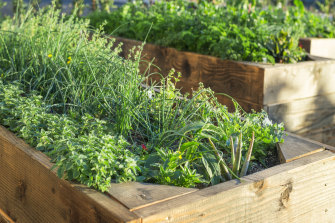Coriander, parsley: the best cold-loving herbs to grow this winter
Basil called it quits in my garden early this year, courtesy of too much rain and not enough sunshine. But there are plenty of other herbs that will carry on through winter, flavouring whatever is going on in the kitchen.
Now is the perfect time to start winter-friendly herbs like rosemary, chervil, and coriander. Credit:iStock
Hardiest of all is rosemary. All of the various cultivars are edible, whether tall and upright or low and spreading; or whether they flower white or pink instead of blue. But some are tastier than others. The cultivars each produce a unique oil. The varieties with oils higher in camphor have a fragrance similar to pine and a bitter flavour. These tend to be the prostrate varieties. The upright varieties tend to be sweeter, and more “rosemary-scented”, such as the popular “Tuscan Blue”. The two renowned for especially fragrant oils are “Herb Cottage” and “Gorizia”. The latter has exceptionally long needles; one for the collectors.
Rosemary evolved in hard-scrabble conditions, eking out a living on windblown rocky cliffs in the Mediterranean. But shown a bit of love and affection in rich garden soil, rosemary luxuriates. If you can’t grow it at your place, beg a few stems from a friend; they’ll keep in a few centimetres of water in a glass for weeks.
In the kitchen, rosemary is a natural fit with potatoes and lamb, and is also good chopped very finely, mixed with heaps of fresh ground pepper and pressed into a steak about to go on the barbecue.
Common thyme hangs in through winter to provide fragrant leaves on which to place roasting chicken bits, though it can look ratty by spring. Cut off straggly stems once the weather warms to power fresh new growth. I don’t find lemon thyme as useful in the kitchen as common thyme, but it is even less bothered by cold weather.
Coriander is a nightmare to grow through summer when the hot weather encourages it to bolt to seed. Now is perfect. Take care transplanting seedlings as any root disturbance also triggers flowering. If coriander does start to flower, let it go, as a thank you to the neighbourhood bees, which appreciate its late winter pollen.
“Coriander is a nightmare to grow through summer when the hot weather encourages it to bolt to seed.”
Chervil is another tender herb that won’t grow well through summer, and doesn’t mind what passes for winter in Sydney. Its delicate anise flavour is lovely in scrambled eggs or tossed over panfried zucchini.
I like to grow parsley and dill through winter too. Both grow better in the garden than in pots as they have a long tap root, and don’t become good strong plants in shallow pots. Dill is good with eggs and cucumber; in a warm potato salad; with green beans and walnuts; and with anything fishy from prawns to salmon. Parsley goes with everything.
These herbs all want good strong sunshine through autumn and winter so grow them in a full sun position where you know the soil won’t get too cold. To get cooking faster start with seedlings, rather than sowing seed. Mulch before the weather turns cold to keep warmth in the soil as long as possible, and give occasional weak liquid fertiliser to keep them growing well and producing fresh leaves.
Make the most of your health, relationships, fitness and nutrition with our Live Well newsletter. Get it in your inbox every Monday.
Most Viewed in Lifestyle
From our partners
Source: Read Full Article
